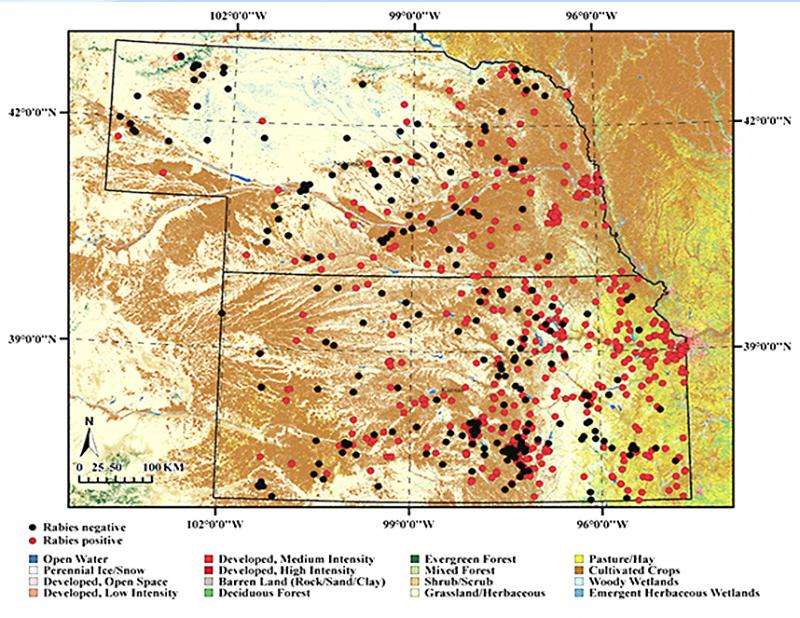Study finds climate, landscape changes may lead to more rabid skunks

While striped skunks already have a nose-worthy reputation for being avoided, new research at the Kansas State University College of Veterinary Medicine finds they carry a serious health threat for humans and animals: rabies.
Researchers in the Kansas State Veterinary Diagnostic Laboratory recently evaluated the spatial and spatio-temporal patterns of infection status among striped skunk cases submitted for rabies testing in the north central Plains of the U.S., including potential eco-climatological drivers of such patterns.
"These animals represent one of the most important terrestrial reservoirs of rabies virus in North America and yet the prevalence of rabies among this host is only passively monitored and the disease remains largely unmanaged," said Susan Moore, director of the Rabies Laboratory. "Vaccination campaigns have not efficiently targeted striped skunks. There are occasional spillovers of striped skunk viruses to other animals, including some pets that are routinely recorded in our lab."
Ram Raghavan, a spatial epidemiologist at the diagnostic laboratory, worked closely with the Rabies Laboratory on this project.
"Our findings indicate the year-to-year and spatial origins of rabies occurrences in Kansas and Nebraska are currently stable," Raghavan said. "Certain physical environment and climatic factors play an important role in determining such temporal and spatial patterns. For example, there is a relatively higher risk of rabies transmission from striped skunks to humans who reside in developed low-intensity areas and highly fragmented landscapes, such as edges of woodlands and agricultural lands, than in other places."
The study, "Bayesian Spatiotemporal Pattern and Eco-Climatological Drivers of Striped Skunk Rabies in the North Central Plains," was recently published in PLOS Neglected Tropical Diseases. The study suggests that daytime temperature range—a climate change indicator that is decreasing at a slow but steady rate—may increase the general risk for striped skunks to contract rabies.
Doug Goodin, professor of geography at Kansas State University, contributed to the study with remote-sensing data to help establish some of the explanatory framework for the project.
"We are trying to understand how important the spatial aspects are in regard to infectious diseases and the applications of microclimatology," Goodin said. "You can't understand the distributions without understanding where things are placed. It seems to be pretty clear that climate will affect the distribution of this disease. The big questions are about which aspects of climate change are going to affect particular disease types. The package of climate variables related to mammals is going to be different than those variables involving diseases spread by insects or arthropods."
"Human-related landscape changes and climate change both appear likely to exacerbate the prevalence of rabies in striped skunks," Moore said. "But further studies are necessary to more fully understand the dynamics of skunk rabies and its impact upon the prevention of rabies among humans and other animals. The important thing is we now have better tools to help try to eradicate rabies in the future."
More information: Ram K. Raghavan et al. Bayesian Spatiotemporal Pattern and Eco-climatological Drivers of Striped Skunk Rabies in the North Central Plains, PLOS Neglected Tropical Diseases (2016). DOI: 10.1371/journal.pntd.0004632














